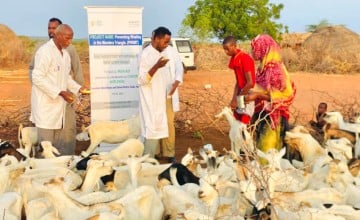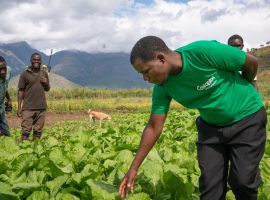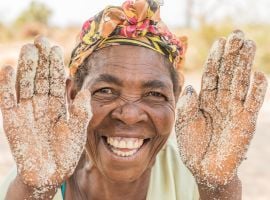
Knowledge Hub
Concern is supporting communities impacted by Horn of Africa drought

Concern Worldwide is ramping up support for communities in Somalia, Kenya and Ethiopia, following forecasts that a continuing drought in the region could leave up to 6.5 million people food insecure and over 2.5 million children malnourished in the coming months.
Kenya is facing a significant drought crisis, primarily due to the failure of seasonal rains since late 2024. The country’s National Drought Management Authority has confirmed that 20 out of 23 counties in the arid and semi-arid lands are experiencing worsening drought conditions.
Kenya faces a “high likelihood of crop failure” as well as depleted pasture, acute water scarcity and the loss of livestock, according to the October–December forecast issued this month by the Intergovernmental Authority on Development Climate Prediction and Applications Centre.
The drought is driving malnutrition with high levels recorded in Turkana, Marsabit, Wajir, Garissa and Mandera, with Baringo North specially classified in critical acute malnutrition (IPC phase 4). Almost 742,000 children under-five years and over 109,000 pregnant and breast-feeding women are acutely malnourished and in urgent need of treatment.
Poor rainfall
In Somalia, poor rainfall, flooding and persistent conflict are driving 3.4 million people into high levels of acute food insecurity (IPC Phase 3 or above) across much of the country. Between July and September 2025, around 624,000 people have experienced emergency levels of acute food insecurity (IPC Phase 4), while more than 2.8 million people have been experienced crisis levels (IPC Phase 3).
The food security situation is expected to worsen up to December as rainfall during the Deyr season (October to December) is forecast to be below normal. This is an important rainfall season for the region, contributing up to 70% of the total annual rains in parts of Kenya and Somalia.
As a consequence, the number of people in Somalia experiencing high levels of acute food insecurity (IPC 3 or above) is projected to rise to 4.4 million people -- 23 percent of the population. The food security situation of people displaced to urban areas in Bay and Bakool is expected to deteriorate from crisis (IPC Phase 3) to emergency (IPC Phase 4).
The Somali Region in eastern Ethiopia has also experienced multiple consecutive poor rainfall seasons since 2021. In 2025, the start of the main pastoral rains (the “gu/genna” cycle) failed in large parts of the region. This has resulted in low pasture and water availability, deteriorating livestock conditions. In many parts of the region, child wasting (acute malnutrition) has surpassed emergency thresholds (>15 %). Funding cuts for treatment and health services has worsened the crisis.
Recurring droughts
Drought has been a recurring issue in the Horn of Africa, with drought fuelling the 2011 famine in Somalia in which over 260,000 people died. Since 2011, Somalia has had only one proper year of rainfall (in 2013) with all other years falling far short of the norm for one or both of the two rainy seasons per year.
The 2021-23 drought was the worst in 60 years in Kenya and Somalia, following five failed rainy seasons. Some 23.5 million people were impacted, 13.2 million livestock died, and seven million children were acutely malnourished.
But since 2011 humanitarian assistance has increased significantly, and resilience and Early Warning Early Action approaches have also contributed to saving lives. This has meant that the impact of the droughts has lessened, and a declaration of famine has been averted, although in 2023 almost 400,000 people experienced famine conditions in Somalia.
A 2023 report by World Weather Attribution concluded that climate change made drought in the region much stronger and more likely; a conservative estimate is that such droughts have become about 100 times more likely.
Concern's response
In Somalia, Concern has provided cash assistance – through the Somali Cash Consortium which Concern coordinates. Loss of lives has been avoided, and families have been able to fend for themselves in such dire straits.
In Turkana and Marsabit – two of the worst affected counties in northern Kenya -- Concern is helping local farmers prepare by providing emergency feed for livestock to maintain health and limit the distances families must travel to reach grazing lands. Livestock health is directly related to food security, and this intervention targets milk production for malnourished children under-three years and pregnant and breast-feeding women.
Concern is also providing:
- Unconditional cash transfers to households.
- Management of emergency nutrition interventions;
- Community hygiene promotion;
- Support to borehole rapid response teams, rehabilitation and upgrading of community water systems;
- The purchase and distribution of hygiene and sanitation items.
Concern’s Hanaano programme, which operates in the remote Mandera triangle – on the Kenya-Somalia-Ethiopia border -- is adopting an integrated approach to tackle child wasting. The Irish Aid-funded programme is responding to the latest drought by providing emergency transport of nutrition supplies to local health centres. It is also providing cash assistance to help families meet essential needs, stabilise food access, prevent deterioration in child nutrition, and support local markets.
Funding cuts warning
“We saw how that the humanitarian response during the 2021-23 drought saved lives and livelihoods,” Concern’s Country Director for Somalia, Richard Nunn said. “But the current drought is occurring in the wake of recent funding cuts which have resulted in significant gaps across the humanitarian response. By October, just 21% of the humanitarian funding needed for Somalia this year had been provided.”
The cuts were very noticeable in sectors such as health, where the UN reports that 170 health facilities have been affected by cuts, he said. This figure is likely to rise as a number of health and nutrition programmes are due to end in the coming months. “These gaps in assistance will exacerbate the impacts of droughts or other emergencies,” he warned.
“We appeal to the international community and the global public to keep eyes on Somalia and to step up financial support to maintain life-saving functions, recovery solutions, critical information sharing channels, data gathering systems and advocacy networks.”
For media queries contact Concern’s Senior Communications Officer, Nicole Bayes-Fleming at [email protected].
Other ways to help
Donate now
Give a one-off, or a monthly, donation today.
Join an event
From mountain trekking to marathon running, join us for one of our many exciting outdoor events!
Buy a gift
With an extensive range of alternative gifts, we have something to suit everybody.
Leave a gift in your will
Leave the world a better place with a life-changing legacy.
Become a corporate supporter
We partner with a range of organisations that share our passion and the results have been fantastic.
Create your own fundraising event
Raise money for Concern by organising your own charity fundraising event.


